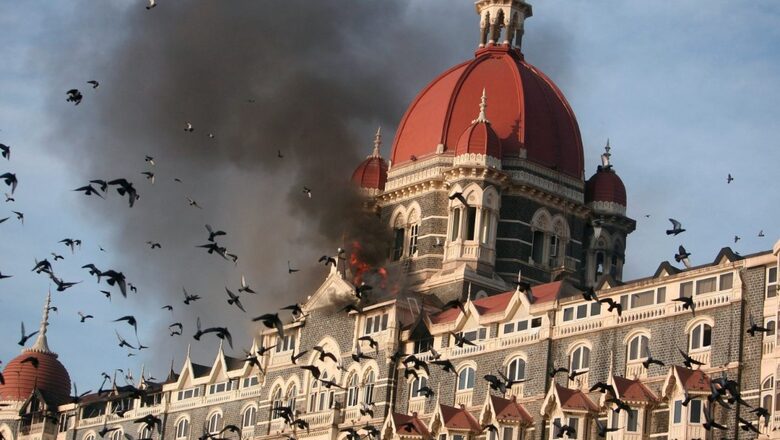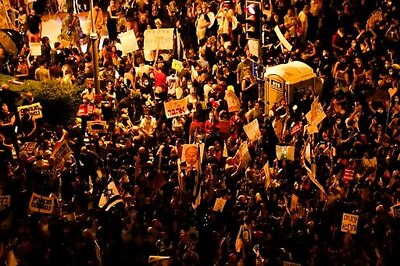
views
When Pakistani terrorists inflicted the dastardly 26/11 terror attacks on Mumbai in 2008, India was caught grossly unprepared. Its counterterrorism approach was found lacking, and various agencies, including Mumbai Police, were seen floundering while they desperately tried to rein in the terrorists. After losing 166 innocent lives and witnessing hundreds get injured, it was the National Security Guard (NSG) that got the situation under control after gunning down nine terrorists and capturing another, Ajmal Kasab alive. The 26/11 attacks became a watershed moment for India. The conscience of the nation was shaken, and the need of the hour was an overhaul of its security apparatus.
The then-UPA government took some measures to reform and strengthen India’s approach to counterterrorism. These included the raising of Sagar Prahari Bal (SPB) and the induction of fast interceptor crafts (FIC) to prevent intrusions from sea. The NIA Act was also passed in 2008, paving the way for the creation of the National Investigation Agency (NIA) to investigate and prosecute terrorism-related cases affecting the sovereignty, security and integrity of the country.
Importantly, the Narendra Modi government has strengthened the NIA and made it a formidable agency crucial to India’s anti-terrorism endeavour. After 26/11, the need for various wings of the Indian military and coastal security agencies to coordinate with each other became more pronounced. This led to the launch of ‘Sagar Kavach’ – a joint exercise between the Indian navy, coast guard and police forces in 2009.
The fact is that India has not witnessed a major terror attack against unarmed civilians since 26/11, and that is because the country has consciously worked to strengthen its counterterrorism apparatus since 2008. For starters, the National Security Guard (NSG) hubs have been set up in different states in order to ensure a rapid response to terror attacks. Today, India is much closer to the West, especially the Ussharing between Indian and Western agencies like the CIA and MI6. India can now get hold of crucial intelligence from its global partners well ahead of a terror attack.
After the 26/11 attacks and until November 2021, more than 300 coastal security exercises were conducted with state authorities by the Indian Coast Guard to dominate the seas and eliminate any and all threats to India. An important exercise, Sea Vigil was conceptualised in 2018 and is being carried out since 2019 by the Indian Navy in tandem with the coast guard and other agencies involved in maritime activities.
The idea to have a specialised agency, called the National Intelligence Grid or NATGRID, which was floated during the UPA tenure. However, it got lost in petty political battles and came into operational existence only under the Modi government in 2020. Today, NATGRID works as an integrated intelligence grid that connects databases of core security agencies of the government. It ensures the quick availability of intelligence to security agencies.
The budgetary allocation for NATGRID has been increased by 108% to Rs 200.53 crore in the 2023-24 Union Budget compared to Rs 96.56 crore in the previous fiscal. Similarly, the Intelligence Bureau, among India’s most important spy agencies, saw its budget being raised by 13% from Rs 3,022 crore in the previous fiscal to Rs 3,418 crore now. The budget for the National Security Council Secretariat under NSA Ajit Doval was also increased from Rs 175 crore to Rs 185.70 crore this year. The home ministry’s budget itself saw a near 6% rise this year as it was increased from Rs 3,022 crore to Rs 3,418 crore.
Having said one cannot ignore the fact that these measures are aimed at strengthening India internally. External deterrence against Pakistan was not established by the UPA while it was in power. The dastardly attack on Mumbai demanded that Pakistan be brought to task – using military force to neutralise its robust terror industry. Due to the lack of political will, however, that deterrence was not established. This ultimately led Pakistan into believing that terror attacks perpetrated against India will invite no military response against it.
The lack of a concrete Indian response paved the way for a series of terror attacks after 26/11, albeit at smaller scales. Mumbai was targeted by multiple bomb blasts just three years later, on July 13, 2011, in which 26 people died and another 121 were injured.
The lack of military deterrence continued until the Uri attack of September 2016. Then, with audacious surgical strikes inside Pakistan Occupied Kashmir, India changed the equation with its western neighbour for good. Unlike the Congress-led UPA government, the Narendra Modi-led NDA government is now much more likely to target Pakistan using the Indian military if Islamabad were to effectuate any provocation. This has no less been admitted to by the American intelligence. In its annual threat assessment report, USA’s Office of the Director of National Intelligence earlier this year informed Congress that “under the leadership of PM Modi, India is more likely than in the past to respond with military force to Pakistani provocations.”
India took its campaign of establishing deterrence against Pakistan a step further in the aftermath of the February 2019 Pulwama attack. The IAF’s precision air strikes against terror bases in Balakot, well within mainland Pakistan, showcased a doctrinal shift in how it responds to terror attacks. India then demonstrated its appetite of entering into a full-blown conflict with Pakistan in case Islamabad made the unwise decision of not returning Wing Commander Abhinandan or causing him harm. India is believed to have delivered direct warnings to Pakistan that failure on their part to return the wing commander would invite a larger escalation, and to back that warning, India deployed its Prithvi ballistic missile batteries in Rajasthan.
The Modi years can best be described as hellish for Pakistan. Today, Pakistan stands globally isolated. It’s only good friend – China — is viewed as part of a global axis of evil. Islamabad’s economy is in tatters, and the Islamic Republic, for all practical purposes, is surviving on borrowed time and money. A big factor that led to Pakistan’s current state of affairs has been India’s proactive global diplomacy since 2014 that exposed Islamabad as a patron of terror groups and a destabilising and rogue entity in the Indian subcontinent.
The Making of a More Secure India
Fifteen years after 26/11, Indians are living in a much more secure environment. Indians today step out of their houses not fearing the prospect of being victims of serial bomb blasts. Only a decade ago, that was not a luxury Indians enjoyed, since serial blasts across the country became normalised as a part and parcel of life. Security agencies are today more empowered to hunt down threats than they were 15 years ago. They are also armed with stringent laws like UAPA and NSA that help them deal with elements that wish to hurt India.
As a result of various measures taken to prevent terror attacks, terrorist-related violence has been on the decline since at least 2011. According to the Global Terrorism Index 2020, 8,749 people were killed in terror attacks in India since 2001. Between 2010 and 2020, the number of terrorist incidents, excluding Kashmir, declined by 70%. The Modi government, on its part, claims that the nation experienced a significant decline in terrorist incidents over the past nine years alone, with 2,350 occurrences resulting in the loss of 377 civilian lives, compared to the UPA era which witnessed 7,327 terrorist incidents and claimed the lives of 2,056 innocent civilians.
Perhaps, the biggest success of Prime Minister Modi’s government has been the turnaround being witnessed in Kashmir. With one swift move in August 2019, the Modi government abrogated Article 370, ending Jammu and Kashmir’s “special status” while also declaring Ladakh and J&K to be separate Union Territories. The move locked Kashmir’s fate as an inalienable part of India. Pakistan was caught by surprise, and this was all done without the shedding of any blood. Remember, so-called experts and even politicians had warned of largescale violence breaking out in Kashmir if the government were to tinker with its special status. None of that happened, and today, Kashmir is finally reaping the benefits of development and peace.
Tourism has witnessed an upswing, with ordinary Indians no longer feeling a threat to their lives if they visit Kashmir. In pure percentage terms, here’s how the law and order situation in Kashmir has improved after the abrogation of Article 370: a drop of 15% in grenade attacks, 77% in IED-related casualties, 60% in weapon snatchings, 92% in stone pelting and 32% in encounters. Further, 11% less civilians have so far been killed in terrorist-related violence, while arson has witnessed a drop of 60%.
The insurgency in Kashmir has been subdued to a great extent, and there are just about two areas which still witnessed regular terrorist-security forces confrontations. Soon, these areas will be sanitised as well. Simultaneously, India has been able to sustain a long ceasefire with Pakistan along the LoC for three years now, although Pakistan now seems intent to disrupt that status quo.
Recent ceasefire violations and also the uptick in encounters with Pakistani terrorists is a reminder that deterrence against Pakistan must be sustained. Pre-emptive strikes, whether carried out from air or by land cannot be reserved for after-the-fact scenarios alone.
That being said, there can be no denying that Pakistan today does not dare to attempt a 26/11-like attack against India, or something even remotely close – especially against civilians. This is largely due to the changed global perception of India. Today, India is viewed as a nation that knows how to give it back as good as it gets – even harder. India has drastically cut down on what was otherwise seen as a cycle of unending violence in its Northeast and Naxal-afflicted areas. Today, the whole of Northeast is calm and peaceful, barring Manipur, where too, ethnic tensions and not insurgency are causing troubles.
Terror deterrence has not just been created against Pakistan, but those who have for decades operated within India too. Naxal violence, for example, witnessed a drop of 77% between 2010 and 2022. The bottom line is: terrorist or violent extremists of any kind today must think several times over before waging a war against India, for the simple fact that it is a war they will lose. India is no longer viewed as a country that will spectate mutely or keep its response to violence mild. The increased deterrence levels are as much applicable to Pakistan as they are to Khalistanis, Naxals or insurgents in the Northeast. The focus must now be on continuously adding to India’s counterterrorism abilities. The fact is that today India’s enemies around the world have started fearing its counterterrorism abilities. That sentiment must be sustained.
Also, an important point to remember is that just as India has prepared itself to deal with 26/11-like attacks, terrorists around the world are experimenting with new ways of fighting as well. Hamas’ barbaric attack against Israel in October serves as a stark reminder of the same. That Hamas was able to hoodwink what is by far the world’s most feared spy agency, Mossad, and plan for the attack for months on end in radio silence should teach India many lessons. The next attack against India might not be something we have seen before. The government and security forces must be prepared for that X factor as well. Only then will we really be secure as a nation.




















Comments
0 comment